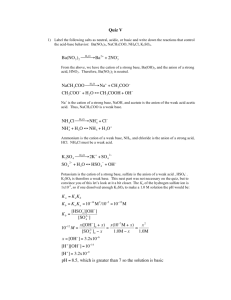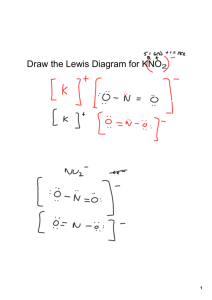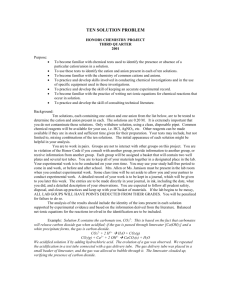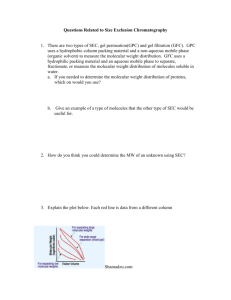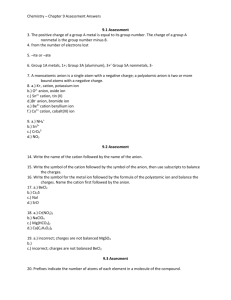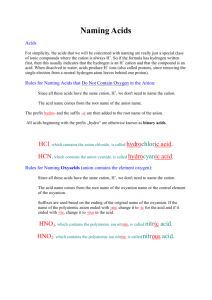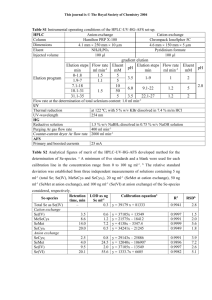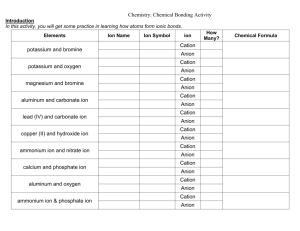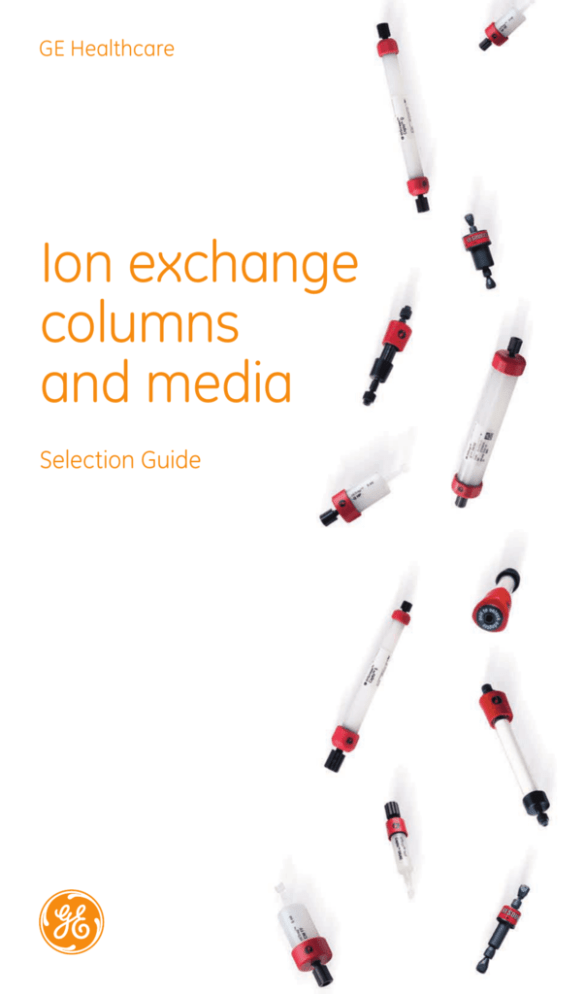
GE Healthcare
Ion exchange
columns
and media
Selection Guide
imagination at work
General information
Ion exchange (IEX) chromatography can separate molecules
or groups of molecules that have only slight differences in
charge. Separation is based on the reversible interaction
between a charged molecule and an oppositely charged
chromatography medium. Typically, conditions are selected
to ensure that the molecules of interest bind to the medium
as they are loaded onto the column. Conditions are then
altered so that the bound substances are eluted differentially.
Elution is most often performed by a continuous gradient
or a stepwise increase in ionic strength, most commonly
using NaCl. Figure 1 shows a typical high resolution gradient
elution. A stepwise elution is illustrated in Figure 3.
Proteins are built up of many different amino acids containing
weak acidic and basic groups (i.e. ionizable groups) that
can be titrated. Hence, the net surface charge of a protein
is highly pH dependent and will change gradually as the
pH of the environment changes. Each protein has its own
unique net charge versus pH relationship which can be
visualized as a titration curve (Figure 2). This curve reflects
how the overall net charge of the protein changes according
to the pH of the surroundings. IEX can be repeated at
different pH values to separate several proteins which
have distinctly different charge properties. Figure 2 shows
how selecting the correct pH is one of the most important
parameters in achieving satisfactory separation.
Choice of ion exchanger
Begin with a strong exchanger (Q, S, SP) to enable development
work to be performed over a broad pH range. Use a strong
anion exchanger (Q) to bind the protein(s) of interest if their
isoelectric point is below pH 7.0 or unknown.
Use a strong exchanger in those cases where maximum
resolution occurs at an extreme pH and the proteins of
interest are stable at that pH.
Consider using a weak exchanger (DEAE, ANX, CM) if the
selectivity of the strong ion exchanger is unsatisfactory,
but remember that the ion exchange capacity of a weak
ion exchanger varies with pH.
sample
injection
volume
equilibration
gradient
elution
wash
re-equilibration
high salt wash
1M
5 CV
tightly bound
molecules
elute in high
salt wash
unbound molecules elute
before gradient begins
[NaCl]
Principle of Ion Exchange
Chromatography
10–20 CV
5–10 CV
5–10 CV
0
Column volumes [CV]
Fig 1. Typical IEX separation using gradient elution.
Selectivity and buffer pH
Figure 2 shows the effect of pH on selectivity. The separation
of three hypothetical proteins at different pH is described
below, and the four scenarios are illustrated in the figure
(see numbered arrows).
1. Most acidic pH: all three proteins are below their
isoelectric point, positively charged, and bind only to a cation
exchanger. Proteins are eluted in the order of their net charge.
2. Less acidic pH: the blue protein is above its isoelectric
point, negatively charged, and the other proteins are
still positively charged. Blue protein binds to an anion
exchanger and can be separated from the other proteins
which wash through. Alternatively, red and green proteins
can be separated on a cation exchanger and the blue
protein washes through.
3. Most alkaline pH: all three proteins are above their
isoelectric point, negatively charged, and bind only to the
anion exchanger. Proteins are eluted in the order of their
net charge.
4. Less alkaline pH: the red protein is below its isoelectric
point, positively charged. Red protein binds to the cation
exchanger, while the other proteins wash through.
Alternatively, blue and green proteins can be separated on
an anion exchanger and the red protein washes through.
1
3
Abs
Multimodal ligands (MMC, adhere) provide ionic interaction,
hydrogen bonding and hydrophobic interaction. MMC behaves
like a weak cation exchanger, but allows binding at high
conductivity. Adhere behaves as a strong anion exchanger.
Abs
Abs
Abs
V
V
V
V
+
Cation
Surface net charge
Chromatography media selection
Select the ion exchange medium according to the objective
of the purification step and the condition of the starting
material. Other factors such as sample stability, scale, speed,
binding capacity and equipment available may also
influence the final choice.
pH
0
Anion
–
Abs
Abs
Abs
Abs
V
V
V
V
2
Fig 2. Effect of pH on selectivity (elution patterns).
4
Sample preparation
Correct sample preparation is essential in order to achieve
optimal separation and avoid deterioration in column
performance. Samples must be clear and free from
particulate matter.
To remove particulate matter, filter (see Buffer Preparation
for filter sizes) or centrifuge (10 000 g for 15 min).
Desalt samples and transfer into the chosen start buffer
using HiTrap™ Desalting 5 ml (volumes up to 1.5 ml) or
HiPrep™ 26/10 Desalting (volumes up to 15 ml).
Very small sample volumes in high salt concentration, with
no major contaminants, can be diluted with start buffer
to lower the salt concentration to a level that does not
interfere with binding to the medium.
Column preparation
Wash away storage solutions and preservatives before
using any IEX medium.
Use prepacked columns to ensure the best performance
and reproducible results.
The volume required for the packed bed is determined
by the amount of sample to be purified and the binding
capacity of the medium. Pack a column that will have
approximately 5-fold excess of the binding capacity
required with a bed height up to 20 cm.
Method development and
optimization (in priority order)
1.Scout for optimum pH by testing a range of pH values
within which the proteins of interest are known to
be stable. If the isoelectric point of the target protein
is known, then begin with a narrower pH range, for
example, 0.5–1 pH unit away from the isoelectric point.
2.If required, scout for optimum selectivity (testing strong
or weak exchangers) using automatic media scouting.
3.Scout for the steepest gradient that gives acceptable
resolution at the selected pH.
4.Scout for the highest flow rate that maintains resolution
and minimizes separation time. Check recommended
flow rates for the specific medium.
5.Scout for the maximum sample load that can be applied
while maintaining satisfactory resolution. In general,
loading 20–30% of the total binding capacity of the
column gives optimal resolution with gradient elution.
6.For large-scale purification, separation times and buffer
consumption can be reduced by transfer to a stepwise
elution as shown in Figure 3.
high salt wash
1M
See Table 1 for recommendations on volatile and nonvolatile buffer systems.
Buffering ions should have the same charge as the functional
groups on the IEX medium and a pKa within 0.6 pH units
of the working pH.
Use a buffer concentration sufficient to maintain buffering
capacity and constant pH, typically 20–50 mM.
Filter buffers after all salts and additives have been included,
and always use high quality water and chemicals. Use 1 µm
filters for particle sizes > 90 µm, 0.45 µm filters for 34 µm
particles, or 0.22 µm filters for particles sizes < 15 µm or
when sterile or extra clean samples are required.
To avoid formation of air bubbles, ensure that the column
and buffers are at the same temperature.
For samples with unknown charge properties, try the following:
– anion exchange (Q)
start buffer: pH 8.0
elution buffer: start buffer including 1 M NaCl, pH 8.0
– cation exchange (S or SP)
start buffer: pH 6.0
elution buffer: start buffer including 1 M NaCl, pH 6.0
[NaCl]
Buffer preparation
sample
injection
volume
unbound
molecules
elute
elution of
unwanted
material
elution
of target
molecule
5 CV
5 CV
tightly bound
molecules
elute
5 CV
equilibration
re-equilibration
5–10 CV
0
5–10 CV
Column volumes [CV]
Fig 3. Typical IEX separation using stepwise elution.
Column cleaning
Correct preparation of samples and buffers and application
of a high salt wash (1 M NaCl) at the end of each separation
should keep most columns in good condition. However,
reduced performance, a slow flow rate, increasing back
pressure or complete blockage are all indications that the
medium needs to be cleaned using more stringent
procedures in order to remove contaminants.
It is recommended to reverse the direction of flow during
column cleaning so that contaminants do not need to pass
through the entire length of the column. The number of
column volumes and time required for each cleaning step
may vary according to the degree of contamination. If the
cleaning procedure to remove common contaminants does
not restore column performance, change the top filter
(when possible) before trying alternative cleaning methods.
Care should be taken when changing a filter as this may
affect the column packing and interfere with performance.
Note: For recommended flow rates, refer to the table
“Products for Ion Exchange.”
Removal of common contaminants
The following procedure should be satisfactory to remove
common contaminants:
1.Wash with at least 2 column volumes (CV) of 2 M NaCl.
2.Wash with at least 4 CV of 1 M NaOH (same flow as step 1).
3.Wash with at least 2 CV of 2 M NaCl (same flow as step 1).
4.Rinse with at least 2 CV of distilled water (same flow as
step 1) until the UV-baseline and eluent pH are stable.
5.Wash with at least 4 CV of start buffer or storage buffer
(same flow as step 1) until pH and conductivity values
have reached the required values.
Removal of precipitated proteins
1.Inject 1 CV of pepsin (1 mg/ml in 0.5 M NaCl, 0.1 M acetic
acid). Leave overnight at room temperature or for 1 h
at 37°C.
2.Rinse with at least 2 CV of distilled water until the UVbaseline and the eluent pH are stable.
3.Wash with at least 4 CV of start buffer or storage buffer,
same flow as step 2, until eluent pH and conductivity have
reached the required values.
Alternative procedure:
1.Wash with 2 CV of 6 M guanidine hydrochloride.
2.Wash immediately with at least 5 CV of buffer at pH 7–8.
3.Rinse with at least 2 CV of distilled water (same flow as
step 2) until the UV-baseline and eluent pH are stable.
4.Wash with at least 4 CV of start buffer or storage buffer
(same flow as step 2) until pH and conductivity values
have reached the required values.
Removal of lipids, hydrophobically bound proteins
or lipoproteins
Organic solvents or detergents may be required to completely
remove contaminants of this type.
Before using organic solvents, wash the medium with at
least 4 CV of distilled water to avoid any salts precipitating
on the column.
When applying organic solvents or solutions it may be
necessary to reduce the flow rate to avoid over-pressuring
the column.
Use cleaning solutions such as up to 100% isopropanol, up
to 100% methanol, up to 100% acetonitrile, up to 2 M NaOH,
up to 75% acetic acid, up to 100% ethanol, ionic or nonionic detergents. Always check for solvent compatibility in
the instructions supplied with the medium or column.
Avoid anionic detergents with Q, DEAE and ANX charged
groups. Avoid cationic detergents with S, SP and CM
charged groups.
Cleaning procedure: alternative 1
1.Wash with 4 CV of up to 70% ethanol or 30% isopropanol.
2.Rinse with at least 2 CV of distilled water until the UVbaseline and eluent pH are stable.
3.Wash immediately with 3 CV of start buffer (same flow
as step 2).
Cleaning procedure: alternative 2
1.Wash with 2 CV of detergent in a basic or acidic solution
(e.g. 0.1–0.5% non-ionic detergent in 0.1 M acetic acid).
2.Rinse with 5 CV 70% ethanol to remove residual detergent.
3.Rinse with at least 2 CV of distilled water (same flow as
step 1) until the UV-baseline and the eluent pH are stable.
4.Wash with 3 CV of start buffer (same flow as step 1).
Technical information
Table 1. Non-volatile and volatile buffer systems
Buffers for anion exchange chromatography
pH interval
Substance
Conc. (mM)
Counter-ion
4.3–5.3
4.8–5.8
5.5–6.5
6.0–7.0
6.2–7.2
8.6–9.6
7.3–8.3
7.6–8.6
8.0–9.0
8.0–9.0
8.4–9.4
N-Methylpiperazine
Piperazine
L-Histidine
Bis-Tris
Bis-Tris propane
Bis-Tris propane
Triethanolamine
Tris
N-Methyldiethanolamine
N-Methyldiethanolamine
Diethanolamine
Cl
Cl or HCOO
Cl
Cl
Cl
Cl
Cl or CH3COO
Cl
2SO4
Cl or CH3COO
Cl
8.4–9.4
9.0–10.0
9.2–10.2
10.0–11.0
10.6–11.6
Propane 1,3-diamino
Ethanolamine
Piperazine
Propane 1,3-diamino
Piperidine
20
20
20
20
20
20
20
20
20
50
20 at pH 8.4
50 at pH 8.8
20
20
20
20
20
1
1
pKa (25 °C)
-
4.75
5.33
6.04
6.48
6.65
9.10
7.76
8.07
8.52
8.52
8.88
-
8.88
9.50
9.73
10.55
11.12
Cl
Cl
Cl
Cl
Cl
rd
Ref: Handbook of chemistry and physics, 83 edition, CRC, 2002–2003.
Buffers for cation exchange chromatography
pH interval
1.4–2.4
2.6–3.6
2.6–3.6
3.3–4.3
3.3–4.3
3.7–4.7
5.1–6.1
4.3–5.3
5.2–6.2
5.6–6.6
6.7–7.7
7.0–8.0
7.8–8.8
1
Substance
Conc. (mM)
Maleic acid
Methyl malonic acid
Citric acid
Lactic acid
Formic acid
Succinic acid
Succinic acid
Acetic acid
Methyl malonic acid
MES
Phosphate
HEPES
BICINE
20
20
20
50
50
50
50
50
50
50
50
50
50
Counter-ion
+
Na
+
+
Na or Li
+
Na
+
Na
+
+
Na or Li
+
Na
+
Na
+
+
Na or Li
+
+
Na or Li
+
+
Na or Li
+
Na
+
+
Na or Li
+
Na
1
pKa (25 °C)
1.92
3.07
3.13
3.86
3.75
4.21
5.64
4.75
5.76
6.27
7.20
7.56
8.33
rd
Ref: Handbook of chemistry and physics, 83 edition, CRC, 2002–2003.
Volatile buffer systems
pH range
3.3–4.3
3.3–4.3; 4.8–5.8
3.3–4.3; 9.3–10.3
4.3–5.8
4.3–5.3; 9.3–10.3
3.3–4.3; 8.8–9.8
4.3–5.3; 8.8–9.8
5.9–6.9; 9.3–10.3
5.9–6.9; 8.8–9.8
5.9–6.9; 8.8–9.8
5.9–6.9; 8.8–9.8
4.3–5.3: 7.2–8.2
1
Buffer system
Formic acid
Pyridine/formic acid
Trimethylamine/formic acid
Pyridine/acetic acid
Trimethylamine/acetic acid
Ammonia/formic acid
Ammonia/acetic acid
Trimethylamine/carbonate
Ammonium bicarbonate
Ammonium carbonate/ammonia
Ammonium carbonate
N-ethylmorpholine/acetate
Counter-ion
+
H
HCOO
HCOO
CH3COO
CH3COO
HCOO
CH3COO
2CO3
HCO3
2CO3
2CO3
HCOO
1
pKa-values for buffering ions
3.75
3.75; 5.25
4.75; 9.81
4.75; 5.25
4.75; 9.81
3.75; 9.25
4.75; 9.25
6.35; 9.81
6.35; 9.25
6.35; 9.25
6.35; 9.25
4.75; 7.72
rd
Ref: Handbook of chemistry and physics, 83 edition, CRC, 2002–2003.
ÄKTAdesign™ chromatography systems provide advice on buffer recipes for each pH and
medium. The BufferPrep function, available in selected systems, compensates automatically for
changes in pH caused by changes in salt concentration and temperature, ensuring constant
pH throughout the separation.
Selection guide - Ion Exchange Media
MiniBeads™ (Q or S)
Selecting an anion or cation exchanger
Isoelectric point (pI)
Ion exchange separates proteins on the basis of differences in their net
surface charge in relation to the pH of the surroundings. The figure below
illustrates how the net charge of a protein can vary with pH. Every protein
has its own charge/pH relationship.
Will Bind
Cation
Exchanger
Polishing
Remove trace impurities or
closely-related substances
Sample condition:
almost pure
Highest resolution mg/run
Select Anion
Exchange at System
pH Above pI
MonoBeads™ (Q or S)
Use for intermediate
purification if column capacity
is sufficient and no scale-up
is required. Can be used for
capture steps if sample is free
from particulate matter.
A 280
5.0
10.0
15.0
ml
A 280
Sample:
Pancreatin
Gradient elution
Mono Q (column 5 × 50 mm)
0
SOURCE 15 (Q or S)
Sample:
Pancreatin
Gradient elution
Mini Q (column 4.6 × 50 mm)
10
20
30
min
Use SOURCE 15 when resolution
is top priority.
A 280
System pH
Will Bind
Anion
Exchanger
Net Charge of Protein
0
4
6
8
Select Cation
Exchange at
System pH
Below pI
10
pH
If isoelectric point (pI) of the target protein is known:
Intermediate
purification
SOURCE 30 (Q or S)
Remove bulk impurities
Sample condition:
partially purified
- select a cation exchanger (S, SP, CM) with a buffer pH below the pI.
Sepharose High Performance (Q or SP)
If pI is unknown:
- test for selectivity using a strong ion exchanger, Q, S or SP. Strong ion
exchangers maintain their charge over a wider pH range than weak
ion exchangers and are suitable for most applications.
A typical purification strategy has three phases: Capture, Intermediate
Purification and Polishing (Cipp). Each phase has a specific objective,
dependent largely on the properties of the starting material. Select
the appropriate ion exchange medium according to the objective of
your purification step and the condition of your starting material.
Use SOURCE 30 when speed is
top priority.
0
10
20
30
min
A 280
High resolution
Easy scale-up
- select an anion exchanger (Q, DEAE, ANX) with a buffer pH above the pI.
Sample:
Pancreatin
Gradient elution
RESOURCE Q, 1 ml
High resolution
High throughput, Easy scale-up
Use HiTrap columns
prepacked with Sepharose High
Performance, Sepharose XL and
Sepharose Fast Flow for media
selection and pH scouting.
Sample:
Pancreatin
Gradient elution
SOURCE 30Q (XK16 × 50 mm)
0
10
20
30
min
A 280
Capture
Isolate, concentrate and
stabilize target protein(s)
Sample condition:
clarified or non-clarified
High purity and yield at high
sample loads for large molecules
MacroCap™ (SP)
Use MacroCap to purify
PEGylated proteins and other
large biomolecules.
0
Easy scale-up, Broad choice of
selectivity, including alternatives
to Q or S ion exchange media
High volume throughput and
high capacity, Easy scale-up
Sepharose Fast Flow
(Q, SP, DEAE, CM, ANX)
Capto™ (Q, S, DEAE, adhere, MMC)
Try weak ion exchangers
such as DEAE, CM or ANX
if the selectivity of Q or S
is unsatisfactory.
Use high bed heights for
increased productivity.
Use MMC for high salt feed.
Sample:
PEGylated
Cytochrome C
Gradient elution
MacroCap
10
20
30
40 min
A 280
Sample:
Pancreatin
Gradient elution
Q Sepharose HP (XK16 × 50 mm)
0
10
20
30
min
A 280
Sample:
Pancreatin
Gradient elution
Q Sepharose FF (XK16 × 50 mm)
High binding capacity for
selected proteins, Easy scale-up
Sepharose XL (Q or SP)
Use Sepharose Q XL virus
licensed as an alternative to
cesium chloride gradients for
purification of viruses, including
adenovirus, or viral vectors.
0
10
20
30
min
A 280
Q Sepharose XL
imagination at work
Large scale, viscous samples
Sepharose Big Beads (Q or SP)
Use with step elution.
0
5.0
10.0
15.0
20.0
Volume (l)
Sample:
Recombinant a-amylase
Pilot scale:
Gradient elution begins
after 20 l
Resolution
Highest resolution μg/run
Use for intermediate purification
if column capacity is sufficient
and no scale-up is required.
Products for Ion Exchange
Bed
Ordering
Column
Information dimensions volume
(ml)
diam. (mm)/
h(mm)/Pack approx.
size
Product
Prepacked columns/Bulk media
Recommended
working
flow range
Maximum
flow
0.1–1.0 ml/min
1 ml/min
Code No.
Mini Q™ PC 3.2/3
17-0686-01
Mini S™ PC 3.2/3
17-0687-01
Maximum
operating
back
1)
pressure
(MPa/psi)
pH
pH
pH
3)
4)
working stability stability
2)
(long
(short
range
term)
term,
cleaning)
Type of ion
exchanger
Nominal bead
size (µm)
Functional group
strong anion
3 (monosized)
-CH2N (CH3)3
Examples of dynamic binding
capacities mg/ml medium
(1 MPa = 10 bar)
3.2/30
3.2/30
0.24
0.24
0.1–1.0 ml/min
1 ml/min
10/1450
10/1450
Prepacked columns/Bulk media
3–11
3–11
3–11
3–11
1–14
1–14
strong cation
3 (monosized)
+
-
-CH2SO3
+
strong cation
90
-CH2CH2CH2SO3
Ribonuclease (Mr 13 700) 5 mg/ml
Lysozyme (Mr 14 300) 5 mg/ml
DEAE Sepharose Fast Flow
25 ml
500 ml
–
50–400 cm/h
750 cm/h
0.3/43
2–9
2–13
1–14
weak anion
90
-O-CH2CHOHCH2N H(CH2CH3)2
α-amylase (Mr 49 000) 6 mg/ml
Trypsin inhibitor (Mr 20 100) 6 mg/ml
17-0709-10
17-0709-01
ANX Sepharose 4 Fast Flow (high sub)
17-1287-10
17-1287-01
25 ml
500 ml
–
50–300 cm/h
400 cm/h
0.3/43
2–9
3–13
2–14
weak anion
90
Ribonuclease (Mr 13 700) 5 mg/ml
Lysozyme (Mr 14 300) 5 mg/ml
-O-CH2CHOHCH2OCH2
+
CHOHCH2N H(CH2CH3)2
CM Sepharose Fast Flow
17-0719-10
17-0719-01
25 ml
500 ml
–
50–400 cm/h
750 cm/h
0.3/43
6–10
4–13
2–14
weak cation
90
-O-CH2COO
11)
11)
11)
11)
90
11)
9)
2–12
2–12
2–14
Strong anion
90
-O-CH2CHOHCH2N (CH3)3
9)
4–12
4–12
3–14
Strong cation
90
-O-CH2CH2SO3
9)
2–9
2–12
2–14
Weak anion
90
-O-CH2CH2N H(CH2CH3)2
9)
3–12
3–12
2–14
Multimodal
strong anion
exchanger
75
-(OCH2CH(OH)CH2) 2N (CH3)
(CH2C6H5)(CH2CH2OH)
N/A
2–12
2–12
2–14
Multimodal
weak cation
exchanger
75
-(OCH2CH(OH)CH2) 2S(CH2)2
CH(COO )NHCOC6H5
> 45 mg BSA/ml medium at 30 mS/cm
2–12
2–12
2–14
Strong anion
90
-O-CH2CHOHCH2N (CH3)3
strong anion
3 (monosized)
-CH2N (CH3)3
Mini S 4.6/50 PE
17-5178-01
4.6/50
0.8
0.5–2.0 ml/min
2 ml/min
18/2600
3–11
3–11
1–14
strong cation
3 (monosized)
-CH2SO3
Mono Q™ 5/50 GL
17-5166-01
5/50
1
0.5–3 ml/min
3 m/min
4/580
2–12
2–12
2–14
strong anion
10 (monosized)
-CH2N (CH3)3
Mono Q PC 1.6/5
17-0671-01
1.6/5
0.1
0.01–0.4 ml/min
0.4 ml/min
5/725
2–12
2–12
2–14
strong anion
10 (monosized)
Mono Q 10/100 GL
17-5167-01
10/100
8
2–6 ml/min
10 ml/min
4/580
HSA (Mr 68 000) 65 mg/ml
Mono Q 4.6/100 PE
17-5179-01
4.6/100
1.7
0.5–3 ml/min
3 ml/ml
4/580
α-lactalbumin (Mr 14 300) 80 mg/ml
Mono Q HR 16/10
17-0506-01
16/100
20
up to 10 ml/min
10 ml/min
3/435
2–12
2–12
2–14
strong cation 10 (monosized)
2–12
2–12
2–14
strong anion
Mono S PC 1.6/5
17-0672-01
1.6/5
0.1
0.01-0.4 ml/min
0.4 ml/min
5/725
Mono S 10/100 GL
17-5169-01
10/100
8
2–6 ml/min
10 ml/min
4/580
Mono S 4.6/100 PE
17-5180-01
4.6/100
1.7
0.5–3 ml/min
3 ml/ml
4/580
Mono S HR 16/10
17-0507-01
16/100
20
up to 10 ml/min
10 ml/min
3/435
RESOURCE™ Q
1 ml
17-1177-01
6.4/30
1
1.0–10 ml/min
10 ml/min
1.5/220
RESOURCE Q
6 ml
17-1179-01
16/30
6
1.0–60 ml/min
60 ml/min
0.6/87
17-5181-01
4.6/100
1.7
0.5–2.5 ml/min
5 ml/min
4/580
SOURCE™ 15Q 4.6/100 PE
2–12
15 (monosized)
1 ml
17-1178-01
6.4/30
1
1.0–10 ml/min
10 ml/min
1.5/220
6 ml
17-1180-01
16/30
6
1.0–60 ml/min
60 ml/min
0.6/87
SOURCE 15S 4.6/100 PE
17-5182-01
4.6/100
1.7
0.5–2.5 ml/min
5 ml/min
4/580
SOURCE 15Q
17-0947-01
17-0947-05
50 ml
200 ml
–
150–900 cm/h
1800 cm/h
0.5/72
2–12
2–12
1–14
strong anion
SOURCE 15S
17-0944-01
17-0944-05
50 ml
200 ml
–
150–900 cm/h
1800 cm/h
0.5/72
2–12
2–13
1–14
strong cation 15 (monosized)
SOURCE 30Q
17-1275-01
17-1275-02
50 ml
200 ml
–
300–1000 cm/h
2000 cm/h
0.3/43
2–13
2–12
1–14
strong anion
17-1273-01
17-1273-02
50 ml
200 ml
–
300–1000 cm/h
2000 cm/h
0.3/43
2–13
2–13
1–14
strong cation 30 (monosized)
17-1153-01
17-1154-01
7/25
16/25
1
5
up to 1 ml/min
up to 5 ml/min
4 ml/min
20 ml/min
0.3/43
2–12
2–12
1–14
strong anion
5 × 1 ml
5 × 5 ml
1–14
strong anion
RESOURCE S
HiTrap Q HP
2–12
1–14
strong cation 15 (monosized)
+
-CH2N (CH3)3
-
15 (monosized)
30 (monosized)
34
+
-CH2N (CH3)3
-
-CH2SO3
+
-CH2N (CH3)3
-
-CH2SO3
+
-CH2N (CH3)3
3–14
strong cation
34
-CH2CH2CH2SO3
HiLoad™ 16/10 Q Sepharose™
High Performance
17-1064-01
16/100
20
up to 5 ml/min
5 ml/min
0.3/43
2–12
2–12
1–14
strong anion
34
-CH2N (CH3)3
HiLoad 26/10 Q Sepharose
High Performance
17-1066-01
up to 5 ml/min
5 ml/min
HiLoad 26/10 SP Sepharose
High Performance
17-1138-01
26/100
53
up to 13 ml/min
13 ml/min
Q Sepharose High Performance
17-1014-01
75 ml
–
up to 150 cm/h
150 cm/h
0.3/43
0.5/72
SP Sepharose High Performance
17-1087-01
75 ml
–
up to 150 cm/h
150 cm/h
0.5/72
MacroCap SP
17-5440-10
17-5440-01
25 ml
100 ml
–
<120 cm/h
<120 cm/h
0.3
HiTrap IEX Selection Kit HiTrap Q FF
9)
4–13
2–12
+
5 ml/min
20 ml/min
IgG (human) (Mr 160 000) 75 mg/ml
1 ml/min
5 ml/min
4 ml/min
20 ml/min
0.3
HiTrap Capto DEAE 5 × 1 ml
5 × 5 ml
28-9165-37
28-9165-40
7/25
16/25
1
5
1 ml/min
5 ml/min
4 ml/min
20 ml/min
0.3
Ribonuclease (Mr 13 700) 75 mg/ml
HiTrap Capto adhere 5 × 1 ml
28-4058-44
7/25
1
0.5 ml/min
4 ml/min
0.3
HiTrap Capto adhere
5 × 5 ml
28-4058-46
16/25
5
2.5 ml/min
20 ml/min
HiTrap Capto MMC 5 × 1 ml
11-0032-73
7/25
1
1 ml/min
4 ml/min
5 × 5 ml
11-0032-75
16/25
5
5 ml/min
17-5316-10
17-5316-02
25 ml
100 ml
–
< 700 cm/h
4–13
2–12
3–14
1–14
strong cation
strong anion
34
34
-
-CH2CH2CH2SO3
+
-CH2N (CH3)3
3–14
strong cation
34
-CH2CH2CH2SO3
Ribonuclease (Mr 13 700) 55 mg/ml
3–12
4–11
2–13
strong cation
50
-CH2CH2CH2SO3
0.10 to 0.13 mmol H+/ml medium
5)
5)
5)
90
5)
2–12
1–14
strong anion
90
-CH2N (CH3)3
17-6002-33
7/25
1
up to 1 ml/min
4 ml/min
0.3/43
5 × 1 ml
5 × 5 ml
17-5053-01
17-5156-01
7/25
16/25
1
5
up to 1 ml/min
up to 5 ml/min
4 ml/min
20 ml/min
0.3/43
2–12
+
17-5054-01
17-5157-01
7/25
16/25
1
5
up to 1 ml/min
up to 5 ml/min
4 ml/min
20 ml/min
0.3/43
4–13
4–13
3–14
strong cation
90
-CH2CH2CH2SO3
HiTrap DEAE FF
5 × 1 ml
5 × 5 ml
17-5055-01
17-5154-01
7/25
16/25
1
5
up to 1 ml/min
up to 5 ml/min
4 ml/min
20 ml/min
0.3/43
2–9
2–13
1–14
weak anion
90
-O-CH2CHOHCH2N H(CH2CH3)2
HiTrap ANX FF (high sub)
5 × 1 ml
17-5162-01
7/25
1
up to 1 ml/min
4 ml/min
0.3/43
2–9
3–13
2–14
weak anion
90
-O-CH2CHOHCH2OCH2
+
CHOHCH2N H(CH2CH3)2
5 × 5 ml
17-5163-01
16/25
5
up to 5 ml/min
20 ml/min
HiTrap CM FF 5 × 1 ml
5 × 5 ml
17-5056-01
17-5155-01
7/25
16/25
1
5
up to 1 ml/min
up to 5 ml/min
4 ml/min
20 ml/min
0.3/43
6–10
4–13
2–14
weak cation
90
-O-CH2COO
28-9365-43
16/100
20
2–10 ml/min
10 ml/min
0.15/22
+
2–12
2–12
1–14
strong anion
90
+
HiPrep SP FF 16/10
28-9365-44
16/100
20
2–10 ml/min
10 ml/min
0.15/22
4–13
4–13
3–14
strong anion
90
-CH2CH2CH2SO3
HiPrep CM FF 16/10
28-9365-42
16/100
20
2–10 ml/min
10 ml/min
0.15/22
6–10
4–13
2–14
weak cation
90
-O-CH2COO
HiPrep DEAE FF 16/10
28-9365-41
16/100
20
2–10 ml/min
10 ml/min
0.15/22
2–9
2–13
1–14
weak anion
90
-O-CH2CHOHCH2N H(CH2CH3)2
Q Sepharose Fast Flow
17-0510-10
17-0510-01
25 ml
300 ml
–
50–400 cm/h
750 cm/h
0.3/43
2–12
2–12
1–14
strong anion
90
-CH2N (CH3)3
-
+
+
-
+
+
10)
0.3
2–12
2–14
Strong anion
90
-O-CH2CHOHCH2N (CH3)3
9)
4–12
4–12
3–14
Strong cation
90
-O-CH2CH2SO3
9)
2–9
2–12
2–14
Weak anion
90
-O-CH2CH2N H(CH2CH3)2
> 700 cm/h
Capto S
17-5441-10
17-5441-01
25 ml
100 ml
–
< 700 cm/h
> 700 cm/h
10)
0.3
Capto DEAE
17-5443-10
17-5443-01
25 ml
100 ml
–
< 700 cm/h
> 700 cm/h
10)
0.3
10)
0.3
10)
0.3
17-5444-10
17-5444-01
25 ml
100 ml
–
< 600 cm/h
> 600 cm/h
Capto MMC
17-5317-10
17-5317-02
25 ml
100ml
–
< 600 cm/h
> 600 cm/h
BSA (Mr 67 000) > 100 mg/ml
2–12
< 700 cm/h
Capto adhere
BSA (Mr 67 000) > 100 mg/ml
-
Lysozyme (Mr 14 500) > 120 mg/ml
+
+
3–12
3–12
2–14
Multimodal
strong anion
exchanger
75
-(OCH2CH(OH)CH2) 2N (CH3)
(CH2C6H5)(CH2CH2OH)
N/A
9)
2-12
7)
2–12
2–14
Multimodal
weak cation
exchanger
75
-(OCH2CH(OH)CH2) 2S(CH2)2
CH(COO )NHCOC6H5
45 mg BSA/ml medium at 30 mS/cm
HiScreen™ Capto S 1 × 4.7 ml
28-9269-79
7.7/100
4.7
2.3 - 4.7 ml/min
4.7 ml/min
0.3/43
4 - 12
4 - 12
3 - 14
strong cation
90
-O-CH2CH2SO3
1 × 4.7 ml
28-9269-78
7.7/100
4.7
2.3 - 4.7 ml/min
4.7 ml/min
0.3/43
2 - 12
2 - 12
2 - 14
strong anion
90
-CH2N (CH3)3
HiScreen Capto DEAE 1 × 4.7 ml
28-9269-82
7.7/100
4.7
2.3 - 4.7 ml/min
4.7 ml/min
0.3/43
2-9
2 - 12
2 - 14
weak anion
90
-O-CH2CH2N+H(CH2CH3)2
HiScreen Capto adhere 1 × 4.7 ml
28-9269-81
7.7/100
4.7
2.3 - 4.7 ml/min
4.7 ml/min
0.3/43
3 - 13
3 - 12
2 - 14
Multimodal
strong anion
exchanger
75
-(OCH2CH(OH)CH2) 2N+(CH3)
(CH2C6H5)(CH2CH2OH)
N/A
HiScreen Capto MMC 1 × 4.7 ml
28-9269-80
7.7/100
4.7
2.3 - 4.7 ml/min
4.7 ml/min
0.3/43
2 - 12
2 - 12
2 - 14
Multimodal
weak cation
exchanger
75
-(OCH2CH(OH)CH2) 2S(CH2)2
CH(COO-)NHCOC6H5
>45 mg BSA/ml medium at 30 mS/cm
7)
Lysozyme (Mr 14 500) > 120 mg/ml
+
HiTrap Q XL 5 × 1 ml
6)
5 × 5 ml
6)
17-5158-01
17-5159-01
7/25
16/25
1
5
up to 1 ml/min
up to 5 ml/min
4 ml/min
20 ml/min
0.3/43
2–12
2–12
2–14
strong anion
90
-CH2N (CH3)3
HiTrap SP XL
5 × 1 ml
5 × 5 ml
17-5160-01
17-5161-01
7/25
16/25
1
5
up to 1 ml/min
up to 5 ml/min
4 ml/min
20 ml/min
0.3/43
4–13
4–13
3–14
strong cation
90
-CH2CH2CH2SO3
BSA (Mr 67 000) > 100 mg/ml
+
-
2–10 ml/min
10 ml/min
0.15/22
2–12
2–12
2–14
strong anion
90
-CH2N (CH3)3
20
2–10 ml/min
10 ml/min
0.15/22
4–13
4–13
3–14
strong cation
90
-CH2CH2CH2SO3
17-5437-10
25 ml
–
100–500 cm/h
700 cm/h
0.3/43
2–12
2–12
2–14
strong anion
90
-CH2N (CH3)3
6)
17-5072-01
300 ml
–
100–500 cm/h
700 cm/h
SP Sepharose XL
17-5073-01
300 ml
–
100–500 cm/h
700 cm/h
0.3/43
4–13
4–13
3–14
strong cation
90
-CH2CH2CH2SO3
Q Sepharose XL
Thyroglobulin (Mr 669 000) 3 mg/ml
HSA (Mr 68 000) 120 mg/ml
α-lactalbumin (Mr 14 300) 110 mg/ml
+
-
+
–
up to 500 cm/h
1800 cm/h
0.3/43
2–12
2–12
2–14
strong anion
200
-CH2N (CH3)3
SP Sepharose Big Beads
17-0657-03
1l
–
up to 500 cm/h
1800 cm/h
0.3/43
4–13
4–13
3–14
strong cation
200
-CH2CH2CH2SO3
Working pH range refers to the pH interval where the medium binds protein as
intended or as needed for elution, without adverse long term effects.
3)
pH stability (long term) refers to the pH interval where the medium is
stable over a long period of time without adverse effects on its subsequent
chromatographic performance.
pH stability (cleaning) refers to the pH interval for regeneration, cleaning-in-place
and sanitization procedures.
5)
6)
7)
HiTrap IEX Selection Kit includes: HiTrap Q FF 1 ml, HiTrap SP FF 1 ml,
HiTrap DEAE FF 1 ml, HiTrap CM FF 1 ml, HiTrap ANX FF (high sub) 1 ml,
HiTrap Q XL 1 ml, and HiTrap SP XL 1 ml.
See important legal information on the backpage about Q Sepharose XL virus
licensed and Capto ViralQ products.
Capto MMC is a multimodal weak cation exchanger and the ligand is charged in
the pH interval 6–10. Outside this pH interval other interactions are still active.
8)
Capto adhere is in antibody processes used in flowthrough mode, and the
loading can be in the region 100–300 mg/ml. The loading conditions should be
optimized in each specific case.
9)
The maximum pressure of the media has not been tested for more than
0.3 MPa (3 bar).
Lysozyme (Mr 14 500) >160 mg/ml
Lysozyme (Mr 14 500) >160 mg/ml
tested for specific application only
-
10)
Lysozyme (Mr 14 300) >160 mg /ml
BSA (Mr 67 000) >130 mg/ml
1l
Maximum operating back pressure refers to the pressure above which the
medium begins to compress.
8)
BSA (Mr 67 000) >130 mg/ml
-
17-0989-03
2)
4)
+
Q Sepharose Big Beads
All ranges quoted are estimates based on our knowledge and experience.
Ovalbumin (Mr 66 000) > 90 mg/ml
BSA (Mr 67 000) >130 mg/ml
20
HSA (Mr 68 000) 110 mg/ml
8)
HiScreen Capto Q 16/100
Ribonuclease (Mr 13 700) 50 mg/ml
Ovalbumin (Mr 66 000) > 90 mg/ml
9)
16/100
Ribonuclease (Mr 13 700) 70 mg/ml
8)
+
9)
28-9365-40
1)
Ovalbumin (Mr 66 000) > 90 mg/ml
+
28-9365-38
BSA (Mr 67 000) 43 mg/ml
BSA (Mr 67 000) > 100 mg/ml
Lysozyme (Mr 14 500) > 120 mg/ml
HiPrep Q XL 16/10
HSA (Mr 68 000) 120 mg/ml
-
+
HiPrep SP XL 16/10
HSA (Mr 68 000) 110 mg/ml
Thyroglobulin (Mr 669 000) 5 mg/ml
BSA (Mr 67 000) 43 mg/ml
Ribonuclease (Mr 13 700) 50 mg/ml
HSA (Mr 68 000) 120 mg/ml
Ribonuclease A (Mr 13 700) 70 mg/ml
α-lactalbumin (Mr 14 300) 100 mg/ml
HSA (Mr 68 000) 110 mg/ml
11)
6)
Ribonuclease A (Mr 13 700) 50 mg/ml
-CH2N (CH3)3
-
5)
Thyroglobulin (Mr 669 000) 5 mg/ml
-
9)
0.3
–
6)
5 × 1 ml
5 × 5 ml
10)
25 ml
100 ml
Q Sepharose XL virus licensed
-
+
IgG (human) (Mr 160 000) 50 mg/ml
Bovine COHb (Mr 69 000) 50 mg/ml
Ribonuclease (Mr 13 700) 70 mg/ml
20 ml/min
> 700 cm/h
Ribonuclease (Mr 13 700) 55 mg/ml
4–13
5)
7)
Ribonuclease (Mr 13 700) 55 mg/ml
BSA (Mr 67 000) 70 mg/ml
-
6)
9)
0.3
28-9032-30
28-9032-31
Capto ViralQ
BSA (Mr 67 000) 60 mg/ml
HiTrap SP FF
HiPrep Q FF 16/10
5 × 5 ml
5
4–13
5)
7 × 1 ml
HiTrap Capto ViralQ 1
5
13 ml/min
20
0.3
7/25
16/25
HSA (Mr 68 000) 50 mg/ml
-
4–13
16/100
4 ml/min
20 ml/min
16/25
Lysozyme (Mr 14 500) 80 mg/ml
4–13
17-1137-01
1 ml/min
5 ml/min
17-5441-22
17-5441-23
HSA (Mr 68 000) 50 mg/ml
0.3/43
HiLoad 16/10 SP Sepharose
High Performance
0.3/43
1
5
28-9078-09
Lysozyme (Mr 14 500) 80 mg/ml
4 ml/min
20 ml/min
up to 13 ml/min
4 ml/ min
7/25
16/25
6)
BSA (Mr 67 000) 45 mg/ml
up to 1 ml/min
up to 5 ml/min
53
1 ml/min
11-0013-02
11-0013-03
6)
1
5
26/100
1
6)
Capto Q
7/25
16/25
5 × 1 ml
5 × 5 ml
7/25
5 × 1 ml
6)
5 × 5 ml
5 × 1 ml
5 × 5 ml
Lysozyme (Mr 14 500) 80 mg/ml
17-1151-01
17-1152-01
HiTrap SP HP
28-9343-88
HiTrap Capto Q HiTrap Capto S BSA (Mr 67 000) 45 mg/ml
-CH2SO3
11)
HiTrap Capto IEX Selection Kit 5 × 1 ml
10 (monosized)
RESOURCE S
SOURCE 30S
2–13
2–12
Thyroglobulin (Mr 669 000) 25 mg/ml
-CH2SO3
-
3–14
1–14
4/580
(1 MPa = 10 bar)
4–13
3–11
3 ml/min
Examples of dynamic binding
capacities mg/ml medium
4–13
3–11
0.5–3 ml/min
Functional group
0.3/43
18/2600
1
Nominal bead
size (µm)
750 cm/h
2 ml/min
5/50
Type of ion
exchanger
50–400 cm/h
0.5–2.0 ml/min
17-5168-01
pH
pH
pH
3)
4)
working stability stability
2)
(long
(short
range
term)
term,
cleaning)
–
0.8
-
Code No.
Maximum
operating
back
1)
pressure
(MPa/psi)
25 ml
300 ml
4.6/50
+
Maximum
flow
17-0729-10
17-0729-01
17-5177-01
-
Recommended
working
flow range
SP Sepharose Fast Flow
α-amylase (Mr 49 000) 6 mg/ml
Trypsin inhibitor (Mr 20 100) 6 mg/ml
Mini Q 4.6/50 PE
Mono S™ 5/50 GL
Bed
Ordering
Column
Information dimensions volume
(ml)
diam. (mm)/
h(mm)/Pack approx.
size
Product
tested for specific application only
The maximum flow rate of the media has not been tested for more than
700 or 600 cm/h.
11)
HiTrap Capto IEX Selection Kit includes: HiTrap Capto Q 1 ml, HiTrap Capto S 1 ml,
HiTrap Capto DEAE 1 ml, HiTrap Capto MMC 1 ml, and HiTrap Capto adhere 1 ml.
Maximum flow velocity (linear flow) is calculated from measurement in packed
columns as follows:
Sepharose Big Beads, ANX Sepharose 4 Fast Flow (high sub): XK50, bed height 25 cm
Sepharose XL and Sepharose Fast Flow: XK50, bed height 15 cm
Sepharose High Performance: BioPilot™ 60, bed height 30 cm
SOURCE 30: FineLINE™ 100, bed height 10 cm
SOURCE 15: RESOURCE, bed height 3 cm
Protein Purification
Handbook 18-1132-29
Gel Filtration
Principles and Methods 18-1022-18
Affinity Chromatography
Principles and Methods 18-1022-29
Antibody Purification
Handbook 18-1037-46
Cell Separation Media
Methodology and Applications 18-1115-69
Ion Exchange Chromatography
& Chromatofocusing
Principles and Methods 11-0004-21
Purifying Challenging Proteins
Principles and Methods 28-9095-31
GST Gene Fusion System
Handbook 18-1157-58
Hydrophobic Interaction and Reversed
Phase Chromatography
Principles and Methods 11-0012-69
2-D Electrophoresis
Principles and Methods
Principles and Methods 80-6429-60
Microcarrier Cell Culture
Principles and Methods 18-1140-62
Recombinant Protein
Purification Handbook
Principles and Methods 18-1142-75
Isolation of mononuclear cells
Methodology and Applications 18-1152-69
GE, imagination at work and GE monogram are trademarks of General Electric Company.
ÄKTAdesign, BioPilot, Capto, Drop Design, FineLINE, HiLoad, HiScreen, HiPrep, HiTrap,
MacroCap, MiniBeads, Mini Q, Mini S, MonoBeads, Mono Q, Mono S, RESOURCE,
Sepharose, and SOURCE are trademarks of GE Healthcare companies.
For contact information for your local office,
please visit, www.gelifesciences.com/contact
www.gelifesciences.com/protein-purification
GE Healthcare Bio-Sciences AB
Björkgatan 30
751 84 Uppsala
Sweden
Separating viral particles with Capto Q products or Q Sepharose XL products may
require a license under United States patent number 6,537,793 B2 and equivalent
patents and patent applications in other countries owned by Centelion SAS. Such a
license is not included with the purchase of Capto Q or Q Sepharose XL but is
included with the purchase of Capto ViralQ or Q Sepharose XL virus licensed products.
With the purchase of Capto ViralQ or Q Sepharose XL virus licensed, the customer is
granted a free limited license under US patent 6,537,793 B2 and equivalent patents
and patent applications in other countries owned by Centelion SAS to separate viral
particles solely through use of the product purchased. All third party trademarks are
the property of their respective owners.
All goods and services are sold subject to the terms and conditions of sale of the
company within GE Healthcare which supplies them. A copy of these terms and
conditions is available on request. Contact your local GE Healthcare representative
for the most current information
© 2000-2008 General Electric Company – All rights reserved.
First published 2000.
GE Healthcare Limited, Amersham Place, Little Chalfont, Buckinghamshire,
HP7 9NA, UK
GE Healthcare Bio-Sciences Corp., 800 Centennial Avenue, P.O. Box 1327, Piscataway,
NJ 08855-1327, USA
GE Healthcare Europe GmbH, Munzinger Strasse 5, D-79111 Freiburg, Germany
GE Healthcare Bio-Sciences KK, Sanken Bldg, 3-25-1, Hyakunincho, Shinjuku-ku,
Tokyo, 169-0073 Japan
imagination at work
18-1127-31 AH 12/2008


